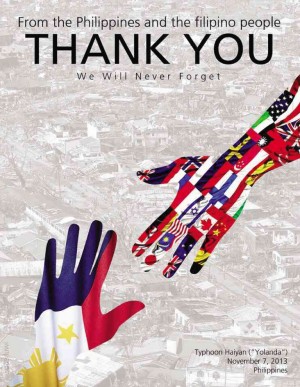
The Filipino people’s resilience was put to the test yet again. Supertyphoon “Yolanda,” the strongest typhoon in history, had a total of six landfalls in the geographic midsection of the Philippines, leaving devastation in its wake.
Leyte, Cebu, Bohol and many other areas have been touched by Yolanda’s wrath. No one has been spared. Thousands have died and homes were destroyed. There are entire towns that have not eaten in days. Potable water is nowhere to be found. Medical attention is at a bare minimum. Roads and bridges are either damaged and destroyed or flanked with corpses and piles of debris.
Days later, matters have taken a turn for the worse. The number of casualties—dead, injured and missing—is rising by the minute, as hunger and thirst transformed into desperation and anger.
But with the help of profit and nonprofit organizations, aid is slowly reaching those who need it the most. Beyond sharing prayers and sympathy, foreign countries have also helped answer the victims’ cries and woes.
Time to move
As I write this article, I am sitting in a cozy chair in a well-lit room, one hand holding a warm cup of frappuccino and the other hitting keys on my laptop.
The reality is, many of us are okay. Yet, while we continue with our daily routines, many are still hungry, homeless and on an endless search for loved ones. Hanging outside one of the shattered churches in Tacloban City is a handwritten sign that reads, “We need help.” They need our help, now more than ever.
We might say that we are still young students with no means to reach out, but we have the power to help them. Small acts of kindness are all that the victims ask of us, and these will make a world of difference to them.
Ways to reach out
Most schools and universities are carrying out their own relief operations. Ask around. Find a way that you can help out. Definitely, they are in need of donations but, more importantly, volunteers. Take a day off from watching your favorite TV series, and spend a couple of hours helping the victims.
Donate, donate, donate. You don’t have to purchase truckloads of goods. All you have to do is search through the things you have and separate those that you don’t need anymore. Pack them and donate them. Many organizations such as Philippine Red Cross are accepting donations that will be distributed to the affected areas, and you can drop off your donations there.
If you know anyone who is looking for someone, Google has launched a database, “Google Person Finder,” to help people search for victims in the typhoon-hit areas in the country.
With this tool, families and friends, especially overseas workers, can locate and check the status of their loved ones. Click on “I’m looking for someone” and type a name, or “I have an information about someone” to provide data.
There are also numerous ways online that we can help. Apart from donating cash, we can also make donations when we purchase products off the Internet. Currently, a lot of businesses are selling their products for the benefit of the typhoon victims. Going beyond a simple status update on Facebook or Twitter can also go a long way. Share posts and links on the current status of the victims and how everyone can help them.
But at the end of the day, there is nothing that can beat the power of prayer. Our country has been battered by typhoons over and over again, but Supertyphoon Yolanda was one we were not prepared for.
But as they say, “The Filipino spirit is waterproof.” Together, we will get through this, like we do every time tragedy strikes our country. Even during the worst of times, Filipinos take pride in the unity, compassion and genuine love that can never be destroyed, even by the most powerful typhoon in history.